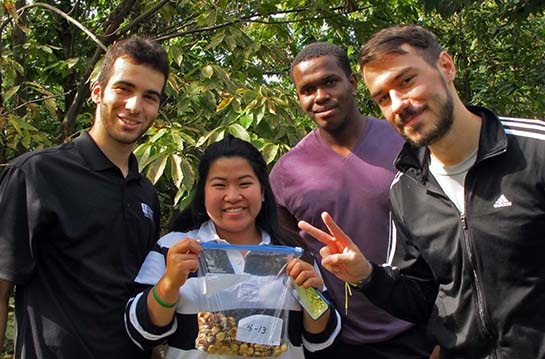
According to Dr. Given, “Neumann’s effort was to assist in harvesting the nuts, a labor-intensive and delicate operation, given the sharp spines on the burs. The seeds are then sent to a ‘library’ at Penn State University and are distributed to other orchards for planting. The two sections of Ecology students harvested over 1,000 seeds!”
The background below about the blight that almost destroyed the American chestnut was prepared by John Wenderoth, who is on the Board of Directors of The American Chestnut Foundation and oversees the chestnut orchard at Tyler Arboretum.
Just as our indigenous human populations were devastated by small pox introduced by European colonists, some native plants have also succumbed to foreign pathogens. One such disease arrived with chestnut trees from Asia.
Over thousands of years, evolution endowed the Chinese chestnut with a high degree of resistance to a particular fungal pathogen. However, by the beginning decade of the past century, that pathogen found its way to America, not with colonizing armies or immigrants, but with a few specimen Asian chestnut trees for a botanical garden in New York. Not long afterward, American chestnuts began dying, and the disease — or blight — spread before scientists understood its cause or how to control it.
In less than five decades, chestnut blight changed the landscape of our Appalachian region by killing as many as four billion trees. Ecological resilience accommodated the loss of nearly every fourth tree in American chestnut’s native range which ran the length of the Appalachian Mountains from New England to Georgia and in parts of even more southern states.
But the American chestnut was not just another tree. Some have called it the perfect tree. Capable of growing to a diameter of five feet and reaching 100 feet in height, its nut crops were a major food source for wildlife and a cash crop for mountain folks who sent wagon loads of chestnuts to market for the fall and winter holidays. The straight trunks produced excellent lumber that was particularly remarkable for its durability.
Fortunately, even though the trunk and leaves of American chestnuts may quickly succumb to the blight, the roots remain viable and continue to send out new sprouts for a number of years — often surviving long enough to flower and fruit — before the fungus kills these young stems.
Though the Chinese chestnut is disease resistant and produces larger nuts that are easier to harvest, it lacks the stature of its American cousin and cannot compete with our tall native trees in the natural landscape. Restoring the American tree to our forests has been the dream of many since the blight began to take its toll.
The American Chestnut Foundation took advantage of the re-growth of our native chestnut. By conserving the genome of the American species in numerous orchards, TACF has initiated a steady effort to capture resistance from the Chinese species through traditional back-cross breeding that should preserve important characteristics of our native species.
 CHALLENGE
CHALLENGE






